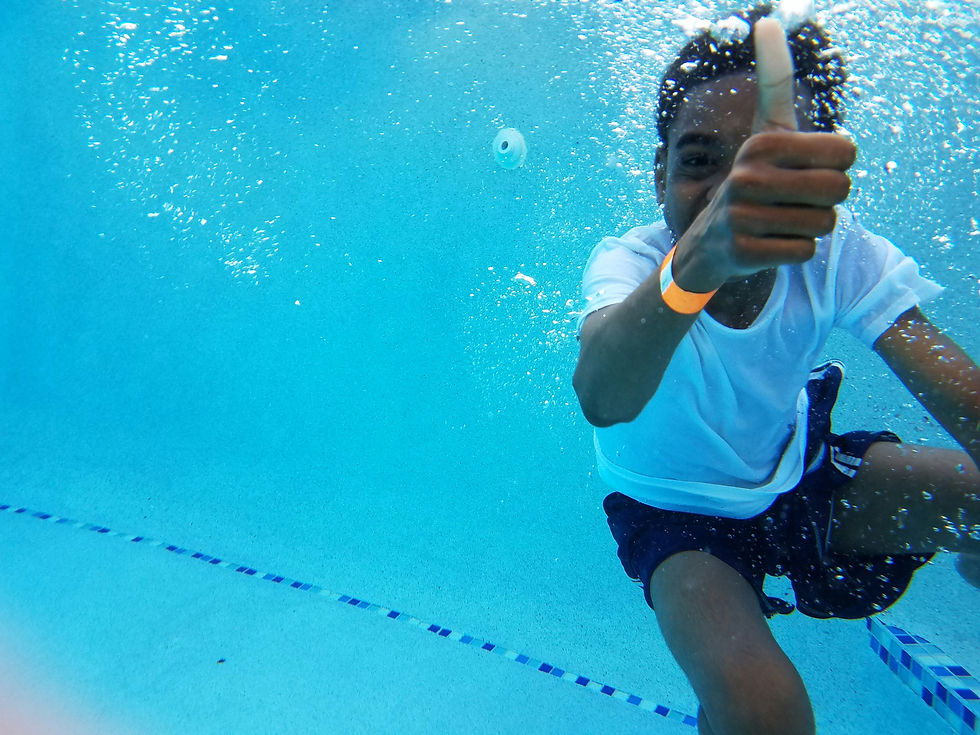The use of cues in during swimming sessions

When teaching young children to swim, cues play a vital role in communication between the parent and child. A cue is a signal or prompt that indicates what’s about to happen, helping the child to prepare mentally and physically. Effective use of cues can make the learning process smoother, build confidence, and ensure safety. This chapter will explore how you, as a parent, can use cues to guide your child’s swimming journey.
Guiding with Cues
Guiding your child with cues is about creating a predictable environment. When your child knows what to expect, they are more likely to respond positively and feel secure. Cues can be verbal, like saying “ready, set, go,” or non-verbal, like a gentle tap on the shoulder. The key is consistency. Always use the same cue for the same activity, and give your child time to process the cue before expecting them to act.
For example, before gently lowering your child into the water, you might say, "Water time!" This simple phrase, repeated each time, helps your child understand that they’re about to enter the water, reducing any potential anxiety.
The Language of Cues
Cues should be simple, clear, and consistent. Children respond best to short, repetitive phrases that they can easily understand and anticipate. For example, "Kick, kick, kick!" is a straightforward cue for encouraging your child to kick their legs. The language of cues should be positive and encouraging. Avoid negative or confusing language, which can lead to uncertainty or fear.
Tone and body language also play significant roles. Your tone should be calm and reassuring, and your body language should be open and inviting. Children are highly sensitive to the emotions behind your words, so a soothing voice and a smile can make a big difference.
Incorporating Cues into Distraction Techniques
Distraction techniques are often necessary when a child is nervous or reluctant. Incorporating cues into these techniques can be particularly effective. For example, if your child is hesitant to put their face in the water, you might use a cue like “Blow bubbles!” This not only distracts them from their fear but also introduces them to an essential swimming skill.
Another technique is to use a favorite toy as a cue. Saying, “Let’s swim to Teddy!” can encourage your child to focus on reaching the toy, rather than on the water itself. The key is to keep the cue playful and engaging, turning what might be a stressful moment into a fun challenge.
Building Confidence with Cues
Cues can significantly boost your child’s confidence in the water. By using consistent and positive cues, you provide reassurance and predictability, which are crucial for building confidence. For instance, if your child is learning to float on their back, you might use the cue, “Starfish time!” every time you practice this skill. Over time, your child will associate this cue with a sense of accomplishment and security.
Praise is also a powerful cue. Simple phrases like “Great job!” or “You did it!” immediately after a successful attempt reinforce the behavior and encourage your child to keep trying.
Cues for Safety and Comfort
Safety is paramount in any swimming lesson, and cues are an essential tool for keeping your child safe. Teaching your child safety cues early on helps them understand when it’s time to be cautious or when it’s safe to proceed. For example, before entering the pool, you might say, “Hold hands,” to remind your child to stay close. Or, “Wait” when it’s time to pause and listen to instructions.
Comfort cues are equally important. These are signals that help your child feel secure, like a comforting touch or a familiar phrase. If your child feels overwhelmed, a cue like “Hug time!” can provide a brief moment of reassurance before continuing with the lesson.

Ten Tips for Using Cues Effectively
1. Start Simple: Use short, clear phrases like “Ready, go!” to indicate the start of an activity. Simplicity helps your child understand and remember the cue.
2. Be Consistent: Always use the same cue for the same action. Consistency helps build trust and predictability.
3. Use Positive Language: Frame cues in a positive manner. Instead of saying, “Don’t be scared,” try, “You’re safe, let’s do this together.”
4. Incorporate Fun Elements: Turn cues into a game. For example, “Race to the wall!” can motivate your child to swim towards the pool’s edge.
5. Pair Cues with Actions: Combine verbal cues with physical gestures, like pointing to the water while saying, “Let’s splash!”
6. Use Visual Cues: Show rather than just tell. Demonstrate an action first and then give the cue for your child to try.
7. Practice Patience: Give your child a moment to respond to the cue. Don’t rush them; allow time for them to process what you’ve said.
8. Reinforce with Praise: After your child follows a cue correctly, reinforce it with positive feedback like, “Great job following directions!”
9. Adjust Cues as Needed: As your child progresses, you may need to modify or introduce new cues. Adapt as they become more comfortable and skilled.
10. Create Safety Cues: Establish clear safety cues like “Slow down” or “Stay by me” that your child understands are important for their protection.

Conclusion
Using cues effectively is a cornerstone of teaching young children to swim. By guiding with clear, consistent cues, you can create a safe and encouraging environment that helps your child build confidence and develop essential swimming skills. Remember, your cues are not just instructions—they are tools for communication, comfort, and connection during this important journey.


Comments